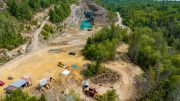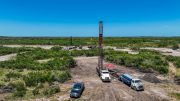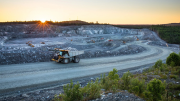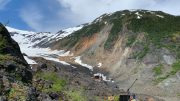New sources of battery metals are needed more than ever before as demand rises for low-emissions vehicles. The eight companies featured below hope to meet that demand for critical minerals and help fuel a greener future.
American Pacific Mining
American Pacific Mining (CSE: USGD; US-OTC: USGDF) holds the Palmer copper-zinc project in Alaska, a joint-venture with Dowa Metals & Mining, and the Madison copper-gold project in Montana.
Palmer is a volcanogenic massive sulphide (VMS) project, 60 km from the port of Haines.
It hosts resources in two deposits: Palmer and the AG Zone. The deposits contain total indicated resources of 4.7 million tonnes grading 5.23% zinc, 1.49% copper, 30.8 grams silver per tonne, 0.3 gram gold and 23.9% barite (BaSO4) for a zinc-equivalent grade of 10.21% or a copper-equivalent grade of 3.92%. Inferred resources total 9.6 million tonnes grading 4.95% zinc, 0.59% copper, 0.43% lead, 69.3 grams silver, 0.39 gram gold, and 27.7% (BaSO4) for 8.87% zinc-equivalent or 3.4% copper-equivalent.

A drill rig at the Tuscarora gold project in Nevada. Credit: American Pacific Mining
A 2019 preliminary economic assessment (PEA) estimated a mine life of 11 years and life-of-mine recovered metal of 1.1 billion lb. zinc, 196 million lb. copper, 18 million oz. silver and 2.9 million tonnes of BaSO4. Initial capex was pegged at US$278 million, and the study estimated an after-tax net present value (at a 7% discount) of US$266 million and an internal rate of return of 21%.
Last year the company drilled the best copper intercepts in Palmer’s history, including 43.8 metres of 6.54% copper, 3.15% zinc, 0.42 gram gold, and 27.91 grams silver (8.22% copper-equivalent) in drill hole CMR23-172.
American Pacific’s past-producing Madison mine, located 48 km from the Butte mine, churned out 2.7 million lb. copper (at grades ranging from about 20% to over 35% copper) and 7,570 oz. gold (grading 16.1 grams gold) between 2008 and 2012 .
Rio Tinto’s (NYSE: RIO; ASX: RIO; LSE: RIO) Kennecott Exploration in February ended its 11-year earn-in agreement to acquire 70% of Madison. It’s now American Pacific’s lead solely owned property.
American Pacific Mining also has gold and silver projects in Nevada, including Tuscarora and Ziggurat, which is under a joint-venture option agreement with Centerra Gold (TSX: CG; NYSE: CGAU).
American Pacific Mining has a market cap of $47.2 million.
Canadian North Resources
Canadian North Resources (TSXV: CNRI; US-OTC: CNRSF) is focused on its 100%-owned Ferguson Lake nickel-copper-cobalt-palladium-platinum project in the Kivalliq region of Nunavut.
Inco discovered base metal and platinum group metal mineralization at Ferguson Lake in the 1950s. Starfield Resources completed a PEA on the project in 2011, before Canadian North acquired the project in 2013. The company then spent nine years on work that included surface sampling and geological mapping, ground geophysical surveys, confirmation assaying, assaying of historic holes that had not been assayed, compiling historic reports, and metallurgical work.
In June 2022, Canadian North updated the Ferguson Lake resource, based on 611 historic diamond drill holes, a total of 186,416 metres of drilling, and 36,740 assay samples. The estimate outlined open pit and underground indicated resources of 24.3 million tonnes grading 0.85% copper, 0.6% nickel, 0.07% cobalt, 1.38 grams palladium per tonne and 0.23 gram platinum for contained metal of 455.4 million lb. copper, 321.4 million lb. nickel, 37.5 million lb. cobalt, 1.1 million oz. palladium and 180,000 oz. platinum.

Talga Group’s Vittangi graphite project in northern Sweden. Credit: Talga Group
Inferred open pit and underground resources add 47.2 million tonnes grading 0.91% copper, 0.53% nickel, 0.06% cobalt, 1.4 grams palladium and 0.25 gram platinum, for 946.9 million lb. copper, 551.5 million lb. nickel, 62.4 million lb. cobalt, 2.1 million oz. palladium, and 380,000 oz. platinum.
The company will update the resource again with the results of 39,270 metres of additional diamond drilling in 145 holes. Highlights from last year’s drilling included 10 metres grading 0.48% nickel, 1.48% copper, 0.06% cobalt, 1.28 grams palladium, 0.06 gram platinum and 0.2 gram rhodium from 656 metres downhole, including 4 metres of 0.60% nickel, 1.59% copper, 0.08% cobalt, 1.54 grams palladium, 0.09 gram platinum and 0.04 gram rhodium, in drillhole FL23-481B.
Canadian North Resources has a market cap of about $174 million.
Delta Lithium
Delta Lithium (ASX: DLI) is exploring for the battery metal at its flagship Mt Ida project in the Goldfields region of Western Australia, 100 km northwest of Menzies.
In October the company delivered a JORC-compliant resource estimate on three pegmatites — Sparrow, Timoni and Sister Sam. They host 7.8 million indicated tonnes grading 1.3% lithium oxide (Li2O) and 6.8 million inferred tonnes of 1.1%Li2OThe resource estimate used a cut-off grade of 0.55% Li2O.
Highlights from infill drilling at Sister Sam include 49.5 metres grading 1.45% from 388 metres, including 12.2 metres grading 1.95% Li2O in hole IDRD07, while drilling outside the existing resource returned 90.1 metres of 0.95% Li2O from 651 metres, including 56.1 metres of 1.1% Li2O in hole IDRD229W1.
Delta is working on studies for a longer-term lithium concentrate project and the potential of a direct shipping ore (DSO) operation. It’s working with the Mid West Ports Authority to finalize an agreement that would accommodate the potential export of DSO and concentrate products from Geraldton Port, about 415 km north of Perth.
The company is also drilling out a gold resource for inclusion in the starter pit.
Delta’s other key asset is its Yinnetharra project in Western Australia’s Gascoyne region, 120 km northeast of Gascoyne Junction. In December, the company reported its first resource based on five pegmatites, with 6.7 million indicated tonnes grading 1.0% Li2O and 19 million inferred tonnes of 1.0% Li2O. The resource estimate used a 0.5% Li2O cut-off grade.
The Malinda prospect, where the company has mapped more than 50 pegmatites, is the focus of exploration. Another 20 pegmatites have been mapped at the Jamesons prospect, 20 km to the west.
Delta Lithium has a market cap of A$206 million (US$134 million).
Foremost Lithium Resource & Technology
Foremost Lithium Resource & Technology (CSE: FAT; NASDAQ: FMST) is a hard rock lithium exploration company working in the Snow Lake region of Manitoba.
Foremost has more than 40 confirmed pegmatite dykes spread across four projects — Zoro (16 lithium dykes), Grass River (17), Peg North (five) and Jean Lake (two beryl pegmatite outcrops).
Exploration at the flagship Zoro project, 20 km east of the town of Snow Lake, dates to 1956. Zoro’s Dyke 1 hosts 1.1 million inferred tonnes grading 0.91% Li2O for 9,700 tonnes of Li2O. The resource used a 0.3% Li2O cut-off grade.
Foremost Lithium completed its most recent drill program at Zoro in April 2022 (1,509 metres in 10 holes) and has planned a 7,500-metre (30 hole) winter drill program focused on Dyke 1. Test results from dense media separation and flotation in March 2023 reported a global lithium recovery of 81.6% at a spodumene concentrate grade of 5.88% Li2O.
At the Jean Lake lithium-gold project, results from a 3,000-metre drill program released in June included intercepts of 3.4 metres at 1.26% Li2O in hole FM23-01A. The company also found gold, reporting 7.7 metres grading 7.5 grams gold and 2.8 metres of 11.27 grams gold. It plans a 2,500-metre winter drill program.
Outside Manitoba, the company has the 48-sq.-km Lac Simard South lithium project in Quebec, about 90 km southwest of the North American Lithium (NAL) joint venture owned by Sayona Mining (ASX: SYA; US-OTC: SYAXF) and Piedmont Lithium (ASX: PLL; NASDAQ: PLL), and the Winston gold and silver project in New Mexico.
Foremost Lithium has a market cap of about $18.3 million.
QC Copper and Gold
QC Copper and Gold’s (TSXV: QCCU; US-OTC: QCCUF) is developing Canada’s highest grade open pit copper deposit at the Opemiska project in the Chapais-Chibougamau region of Quebec.
Opemiska is the largest copper resource in the region and the third largest in Eastern Canada. The copper mine complex includes the past-producing Springer, Perry, Robitaille and Cooke mines. CN Rail infrastructure extends through the property, and between 1953 and 1991, Falconbridge sent concentrate from Opemiska to the Horne smelter, 350 km to the southwest in Rouyn-Noranda.
The company envisions a starter pit with 19.1 million measured and indicated tonnes grading 0.86% copper, 2.13 grams silver per tonne and 0.4 gram gold (1.09% copper-equivalent), using a copper-equivalent cut-off grade of 0.15%. A high-grade starter pit, the company says, should give it more development options and could mean a short payback period.
In January, an updated resource of Opemiska’s pit-constrained and out-of-pit mineralization incorporated a drill hole database of 16,570 surface and underground holes (1 million metres). The total in-pit and out-of-pit resources stand at 97.5 million measured and indicated tonnes grading 0.81% copper, 1.76 grams silver and 0.27 gram gold (0.97% copper-equivalent) for 1.8 billion lb. contained copper, 5.5 million oz. silver, and 845,000 oz. gold (2.1 billion lb. copper-equivalent).
Inferred resources total 11 million tonnes grading 0.53% copper, 2.58 grams silver and 0.2 gram gold (0.65% copper-equivalent) for contained metal of 127 million lb. copper, 907,000 oz. silver and 70,000 oz. gold (157 million lb. copper-equivalent). The resources used an in-pit copper-equivalent cut-off grade of 0.15% and out-of-pit cut-off grade of 0.8%.
The company kicked off a new drill program on the Cooke and Robitaille mines in mid-January. The historic mines are less than a kilometre from QC Copper’s recently defined open-pit resource and the company hopes to identify additional open pit material within these zones.
QC Copper and Gold has a market cap of about $21.7 million.
Talga Group
Talga Group (ASX: TLG) is building Europe’s first natural graphite anode plant at Lulea in northern Sweden and will use natural graphite from the company’s own deposits near Vittangi.
In its first phase, the refinery will produce 19,500 tonnes of graphite anode annually for 24 years. The company began early works and construction in September. Once completed, Talga says, the refinery will produce enough anode material for 16 gigawatt hours (GWh) of battery capacity a year, or enough for about 250,000 electric vehicles.
The company secured an A$31 million (US$20 million) environmental bond facility for the anode project in November and an environmental permit in April to build the Vittangi mine, which hosts the Nunasvaara South-North-East and the Niska North-South graphite deposits. Talga describes Vittangi as Europe’s largest and highest-grade graphite deposit.
In a resource update in April, the company outlined a JORC-compliant resource of 27.8 million indicated tonnes grading 23.8% graphitic carbon (Cg) and 9 million inferred tonnes of 21.2% Cg. The resource used an 11% Cg cut-off grade and included the first resource for new extensions to graphite mineralization at the Niska deposit.
Talga has two other graphite deposits in Sweden: Jalkunen and Raitajarvi. Jalkunen contains an inferred resource of 31.5 million tonnes grading 14.9% Cg. Raitajarvi hosts 3.4 million indicated tonnes averaging 7.3% Cg and 900,000 inferred tonnes grading 6.4% Cg, according to a 2004 JORC resource.
Elsewhere in Sweden, Talga owns 100% of the Aero lithium project. Aero was initially staked for its copper potential, but the company has discovered significant lithium-bearing pegmatites hosting surface mineralization of up to 1.95% Li2O.
The Talga Group has a market cap of A$213 million (US$138 million).
Talon Metals
Talon Metals (TSX: TLO; US-OTC: TLOFF) is in a joint venture with Rio Tinto (NYSE: RIO; ASX: RIO; LSE: RIO) on the Tamarack nickel-copper-cobalt project in central Minnesota. Talon owns 51% of the JV and has an earn-in right to acquire up to 60%.
Under an agreement with Tesla, the project will supply 75,000 tonnes (165 million lb.) of nickel in concentrate — and certain by-products including cobalt and iron — over a six-year period following the start of commercial production.
In November, Talon signed an agreement with the U.S. Department of Energy for US$114.8 million in grant funding for its battery mineral processing facility in Mercer County, Minn. The funds were created by the government’s Bipartisan Infrastructure Law. The announcement followed a grant of US$20.6 million in September from the U.S. Department of Defense to support and accelerate exploration efforts at Tamarack.
The project, about 2 km north of the city of Tamarack, has a total strike length of about 18 km. It contains 8.6 million indicated tonnes grading 1.73% nickel, 0.92% copper, 0.05% cobalt, 0.34 gram platinum, 0.21 gram palladium, 0.17 gram gold , and 8% iron in sulphides (2.34% nickel-equivalent). Inferred resources stand at 8.5 million tonnes grading 0.83% nickel, 0.55% copper, 0.02% cobalt, 0.23 gram platinum, 0.13 gram palladium, 0.13 gram gold and 3% iron in sulphides (1.19% nickel-equivalent).
In addition, the company has intercepted high-grade mineralization outside the resource area. In mid-January, the company reported results from the Raptor Zone, which lies to the north of the resource area. The results included 5.9 metres grading 2.92% nickel and 1.73% copper (4.09% nickel-equivalent) starting from 648 metres downhole, including a 2.2-metre intercept of 6.84% nickel and 3.8% copper (9.31% nickel-equivalent) in hole 23TK0483. It was drilled about 1 km to the north of the current resource.
The company also plans to explore for nickel in Michigan, and in January that state’s department of natural resources approved Talon’s application for 93 sq. km of additional mineral leases in the Upper Peninsula.
Talon Metals has a market cap of about $131 million.
Wildcat Resources
Wildcat Resources (ASX: WC8) is focused on its Tabba Tabba lithium-tantalum project in Western Australia, about 80 km from Port Hedland and 47 km from Pilbara Minerals’ (ASX: PLS) Pilgangoora mine, one of the world’s largest independent hard rock lithium operations producing spodumene and tantalite concentrates.
When Wildcat acquired 100% of Tabba Tabba from Global Advanced Metals last May, 38 pegmatites had been mapped but only one pegmatite, which contains the Tabba Tabba tantalum deposit, had been drilled extensively and most of the samples weren’t assayed for lithium. The last time holes were drilled outside the tantalum deposit was in 2013, when three of four holes at the Hutt prospect intersected pegmatite. Intercepts included 8 metres of 1.42% lithium oxide (Li2O) from 4 metres in hole TDRC02 and 16 metres of 0.9% Li2O from 10 metres in TDRC03.
Wildcat kicked off a reverse-circulation drill program of outcropping pegmatite clusters (Hutt, Han, Leia and Chewy) on the project’s northern and central mining leases in July. By the end of last year, it had drilled nearly 43,000 metres. It plans to drill 100,000 metres in the first half of this year.
In mid-September, initial results from 21 holes confirmed the pegmatites contained significant widths and grades. Intercepts from the Leia pegmatite included 180 metres grading 1.1% Li2O from 206 metres in hole TARC148; 99 metres of 1.2% Li2O from 207 metres in TARC234D; and 85 metres of 1.5% Li2O from 133 metres in TARC128.
The pegmatite containing Tabba Tabba’s tantalum deposit has a historic resource estimate of 318,000 tonnes grading 950 parts per million tantalum oxide (Ta2O5) for 666,2 lb. Ta205. The resource was drilled to a depth of 35 metres and is open in all directions.
Wildcat’s Bolt Cutter project consists of tenements prospective for lithium and gold that surround Tabba Tabba.
Wildcat Resources has a market cap of A$514 million (US$333 million).






Be the first to comment on "Battery metals snapshot: Eight companies charging up"